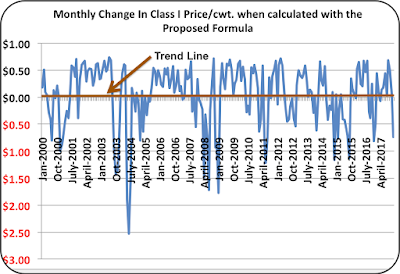Here's the highlights:
POSITIVE CHANGES
- The growth in milk production has slowed.
- Cow numbers decreased in 2019.
- With the slower growth in milk production, cheese inventories have decreased.
BUT
- With higher producer milk prices in the fourth quarter of 2019, the slower growth in milk production is not quite as slow.
- While Cow numbers decreased every month in 2019, the decreases were smaller in the final quarter.
OTHER POSITIVE SIGNS
- Milk per cow has shown a one percent annual increase in 2019. More milk with fewer cows is a very positive parameter for a lower cost of milk production.
- Component levels in milk have increased. Producer payments are mostly based on butterfat and protein, so higher levels of butterfat and protein are a positive trend toward lower costs of component production.
One of the most important parameters for a low-cost producer is to make more milk with fewer cows. In 2019, milk per cow has increased by one percent vs. the prior year (Chart I). The level of increase is a continuation of a very long-term trend of improved productivity. Also, as covered in a prior post, component levels are also rising. Milk volume increases and component level increases per cow together amount to an annual increase of at least 1.5 percent in component production per cow. This increase will likely fulfill or slightly over fulfill the needed production of milk components. Therefore, a steady to lower number of cows will be needed for balancing supply and demand.
 |
| Chart I - Milk per Cow Percent Annual Increase |
 |
| Chart II - Milk Production - Increase vs. Prior Year |
 |
| Chart III - Milk Production 12-MonthMoving Average |
 |
| Chart IV - Milk Production 12-Month Moving Average - Percent Change from Prior Year |
 |
| Chart V - Days Inventory of Cheese |
 |
| Chart VI - Dairy Cow Numbers |
 |
| Chart VII - Diary Cow Numbers - Percent Change from Prior Year |
IS THE DECREASE OF GROWTH IN MILK PRODUCTION ENOUGH?
As shown in Chart IV, the 12-month moving average of milk growth slowed to about .26 percent in August 2019. The fourth quarter of 2019 averaged .33 percent growth. The current growth level of production would reduce cheese inventories if continued. However, cow and milk numbers started growing in the fourth quarter of 2019 with the current higher milk prices. As long as the growth number do not accelerate in 2020, the year should see inventories and milk prices at reasonable levels.




